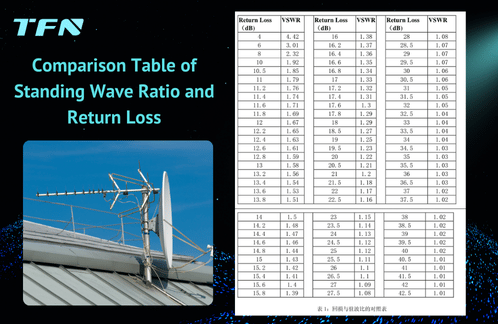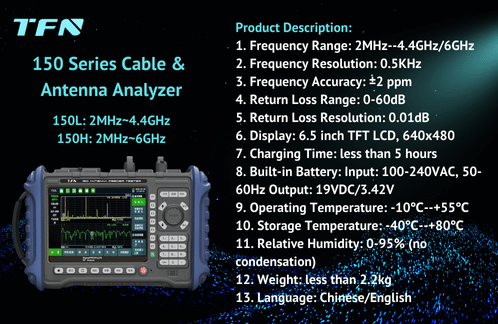Antenna-feeder System Testing And The Impact of Antenna-feeder Systems On The Field Of Mobile Communications
With the rapid development of mobile communication technology, antenna-feeder systems play a vital role in mobile communication networks. Reasonable design and optimization of antenna-feeder systems can significantly improve network performance and ensure user experience. This article will introduce the test methods of antenna-feeder systems, and deeply analyze the impact of antenna-feeder systems on the field of mobile communications.

Antenna-feeder System Overview
Antenna-feeder system is one of the important components of microwave relay communication, and its components mainly include: antenna, feeder, jumper, tower top amplifier, lightning protection device, etc. The antenna plays the role of converting electromagnetic waves transmitted in the feeder into electromagnetic waves propagating in free space, or converting electromagnetic waves propagating in free space into electromagnetic waves transmitted in the feeder. The feeder is the transmission channel of electromagnetic waves. In the microwave relay communication circuit of the multi-channel shared antenna-feeder system, the technical performance and quality indicators of the antenna-feeder system directly affect the communication quality of each microwave channel of the shared antenna-feeder system.
Antenna System Test Method
The installation quality and operation of the antenna feeder system will directly affect the call quality, wireless signal coverage and the working status of the transceiver.
Cable failure (cable breakage, bending, skin damage, water seepage, etc.)
Connector failure (rust, poor connection of intermediate conductor, etc.)
Antenna failure (deviation from design indicators, damage caused by transportation or bad weather)
Transmission line and installation factors
These factors will affect the quality of the antenna-feeder system. In terms of parameters, the test of the antenna-feeder system is mainly to judge the installation quality and operation of the antenna feeder through the standing wave ratio (VSWR) and return loss.
Standing wave ratio: refers to the ratio of the voltage amplitude of the antinode of the transmission line to the voltage amplitude of the trough. When the standing wave ratio is equal to 1, it means that the impedance of the feeder and the antenna is completely matched. At this time, all the high-frequency energy is radiated by the antenna, and there is no reflection loss of energy. This is the most ideal situation. If the standing wave ratio is greater than 1, it means that part of the radio wave is reflected back and eventually becomes heat, causing the feeder to heat up. The reflected radio waves can also generate quite high voltage at the output port of the transmitter, which may damage the transmitter.

Return loss: It is a parameter that indicates the signal reflection performance, indicating that part of the incident power is reflected back to the signal source. For example, if 1mW (0dBm) power is injected into the amplifier, 10% of which is reflected (bounced) back, the return loss is 10db. The greater the return loss, the smaller the return. When the return loss is positive infinity, the return is completely lost, there is no return, and the system is well impedance matched. So the greater the return loss, the better.
The test of antenna-feeder line is to determine the frequency band of the antenna-feeder line to be tested, and select the corresponding frequency band in the antenna-feeder line tester. Then calibrate the frequency band. After calibration, the antenna-feeder line to be tested can be tested, including VSWR, matching test (return loss) and fault location.
The Impact of Antenna-feeder System on Mobile Communication Field
1. Improve network coverage and capacity:
The antenna-feeder system directly affects the coverage and signal quality of the base station. High-gain and high-sensitivity antennas can expand the coverage range and reduce blind spots. At the same time, reasonable feeder design and optimization can reduce signal loss and improve network capacity and reliability.
2. Improve user experience:
A high-quality antenna-feeder system can reduce call drop rate and delay and increase data transmission speed. This is crucial to user experience, especially in today's rapid development of mobile Internet, where users have higher and higher expectations for communication services. A stable antenna-feeder system can ensure that users have a good communication experience in high-speed mobile or edge coverage areas.
3. Reduce operating costs:
An optimized antenna-feeder system can effectively reduce power consumption and reduce operating and maintenance costs. At the same time, by reducing the failure rate and improving system reliability, operators can reduce maintenance and equipment replacement expenses, thereby reducing overall operating costs.
4. Support new technology deployment:
The introduction of 5G technology has put forward higher requirements for antenna-feeder systems, such as higher frequency, larger bandwidth and lower latency. The optimized antenna-feeder system can effectively support the deployment and evolution of 5G new technologies and ensure the efficient operation of the new generation of mobile communication networks.
As a key component of mobile communication networks, the performance of antenna-feeder systems directly affects the coverage, capacity and user experience of the network. Through scientific testing and optimization, ensuring the efficient operation of antenna-feeder systems can greatly improve the quality and reliability of mobile communication services. In the future development, with the continuous advancement of technology, antenna-feeder systems will continue to play an irreplaceable and important role in the field of mobile communications.

TFN's new product--150 series handheld antenna feeder tester is officially launched, including voltage standing wave ratio (VSWR), return loss, cable loss, electronic calibration components, terminal power meter and other functions, with accurate testing, durable and reliable
150L (frequency range: 2MHz~4.4GHz)
150H (frequency range: 2MHz~6GHz)
If you are interested in TFN 150 series handheld antenna feeder tester, please contact TFN sales team:
Email: info@tfngj.com
WhatsApp: +86-18765219251
Facebook: https://www.facebook.com/tfnfate/
